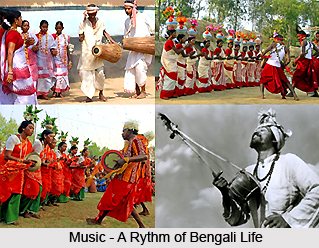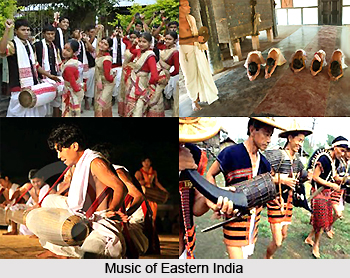 Tribal music in East India is filled with rich historical evidences. Musicological enquiry of folk-music of eastern India, having numerous varieties of primitive and tribal music at its background, needs examination of some aspects of the subject.
Tribal music in East India is filled with rich historical evidences. Musicological enquiry of folk-music of eastern India, having numerous varieties of primitive and tribal music at its background, needs examination of some aspects of the subject.
Some of them still cling to their primitive or old traditions. Music of the scheduled tribes forms isolated classes. Most of the music of the scheduled tribes possesses similarities and dissimilarities in respect of ethnic peculiarities of the sections to which they belong. Tunes and rhythm are set to compositions in their mother tongues and some of these sections have formed very small groups.
The approximate number of varied dialects of tribes in other states may be summarized thus: Arunachal Pradesh 12; Manipur 29; Meghalaya 14; Mizoram 10; Nagaland 13 and Tripura 19. These numbers do not include the dialects of sub-tribes like Kukis of Indian state of Meghalaya and Tripura etc. Most of these tribes follow their own dialects some of them use mixed dialects and remain separate from the general rural agricultural people.
There is another classified group of population known as the scheduled caste. They are connected with the urban and agricultural society, and their music is generally included in the songs of the agricultural class.
In India, largest section of the population lives in rural and agricultural areas. Of them, the folk (rural) people, who happen to be in touch with urbanized city life, are inseparably connected with both the cultured people and the primitives. Their connection is sustained on religious grounds and they live as co-existing neighbours but in complete isolation from others.
Hence some aspects of folk-music, i.e., the musical forms of the cultured level, may be segregated from extant primitive forms. Virtually, the agricultural people of this vast country inherit the rural vocal traditions. Marks of primitiveness may exist as minor characters in some. Then, again, the topography of the land may also be seen to expose directly the characteristic vocal art. The rural and agricultural people, connected with civilized and cultural societies, are distinct from counterparts with whom they inhabit as neighbours. It is these people who are generally classified, from the administrative point of view, as backward classes, scheduled castes and tribes. Some of the scheduled castes live a primitive life in the plains, although they are considered as the part of some religious societies. Of course, a section of these people live an isolated life preserving their own traditions as lower caste groups, and some of them live at a distance from the cultured society. They maintain different aspects of music separately, each one holding a tradition of its own type. But the most characteristic instances are the music of various tribes.
 The term "tribe" now means the population remaining isolated in smaller groups far from the civilized world. A racial group of common descent, with common dialect and common culture acting together for common purposes and usually confined to specific and smaller areas, is generally termed as a tribe. The earlier idea of extended kinship is no longer in use now. The then concept, which referred to the existence of intermarrying units, trade relations, common cult or age grade organization of groups settled in definite localities, has dissolved into a few peculiarities only.
The term "tribe" now means the population remaining isolated in smaller groups far from the civilized world. A racial group of common descent, with common dialect and common culture acting together for common purposes and usually confined to specific and smaller areas, is generally termed as a tribe. The earlier idea of extended kinship is no longer in use now. The then concept, which referred to the existence of intermarrying units, trade relations, common cult or age grade organization of groups settled in definite localities, has dissolved into a few peculiarities only.
The scheduled tribes can be generally ascertained by the fact that they live apart in hills, and even where they live on the plains, they had a separate excluded existence, and are not fully assimilated in the main body of the people. Indian Scheduled tribes may belong to any religion. They are treated as scheduled tribes because of the kind of life led by them. The recent official definition of scheduled tribe as "a distinctive social organization and mode of life" confirms the revised ideas.
It may be pointed out that a psychological aversion to the use of the term was marked to exist among certain cultured hill people of the eastern region of India. A tribal individual may either be in an early primitive stage or he may be a sophisticated citizen no longer remaining primitive in his individual life; but it may be natural for him to maintain his relationship with the group to which he belongs. A person like this, as it is often observed, may take more interest in reorientation of cultural habits like music and dance.
Mizos of the eastern area, a large section of who are educated and cultured have shunned most of their old tradition of musical habits and started cultivating Western music. Whatever may be the racial classification, hill people or tribe, the fact remains that the larger section of these people are extant in isolated areas inside the boundaries of their own social walls preserving the locale in their culture. Mere elements of imbibed music based on its rudimentary forms cannot remove physiological, psychological and vocal articulation of group in any way. An imbibed culture can hardly dislodge the inherent culture. The original materials on data should be preserved for adequate study.
It does not matter if any individual or a group of a tribe or a primitive man performs somewhat cultured music suitable for popular entertainment, or general rural sources. The term "primitive music" (music of Adivasis/tribes) signifies the form of music of ethnic group and also includes the locale which may be found to preserve both its ethnic and folk characters.
Primitive music of different groups carries different features of expressions consistent with various racial characteristics. Apparently, though some group of people are considered primitive in many respects, they may maintain the tradition of various religious impacts providing elements of music far from ethnic groups, e.g., Gambhira, Gajan and such songs as sung by Adivasis of western borders and few types of Jhumur songs influenced by Santals.
Some Naga music in present day indicate combination of two-note or three-note in harmonic forms (western) of repeating groups along with ethnic drumming. People of the soil of the north-eastern border of Bengal and Orissa preserve lots of hybrid music which may not be entirely categorized as ethnic, though the origin from ethnic sources cannot be denied. It may be observed that certain preliterate Adivasis (tribes) maintain oral materials in the same way through the ages. But; their habits and methods of entertaining performances may not indicate any feature of remarkable changes in some cases. Some tribes of Tripura named Tripuris, Riangs and so on, perform songs individually (solo), and they also have undergone hybridization at some instances. The habit of individual performance facilitates some gifted singers in specialization, but this is rare. A half clad man who hardly received any touch of developed music, rather living a tribal life, may sing to accompaniment of a folk idiophone instrument, a song of rare quality of developed type in his dialect.





















